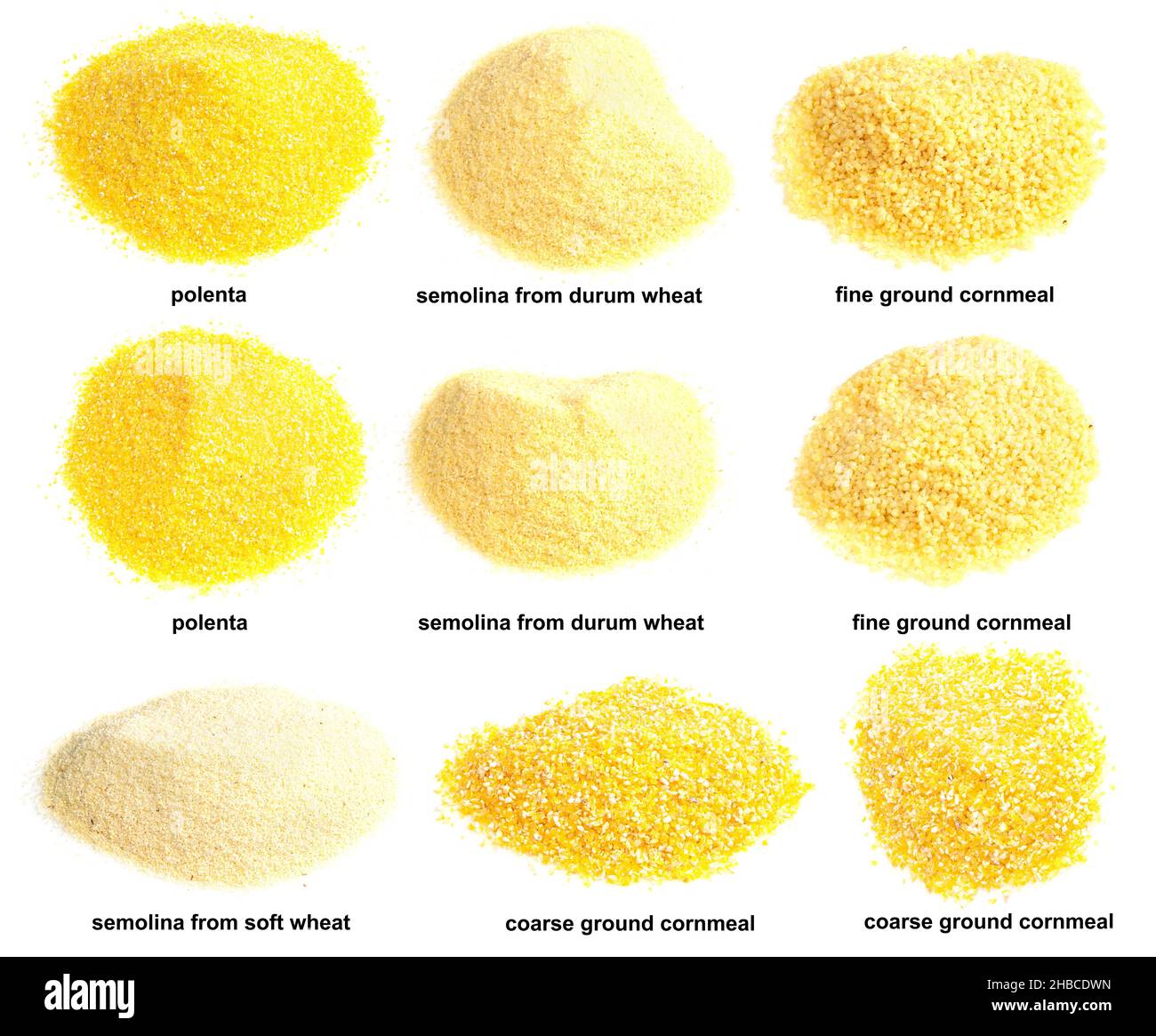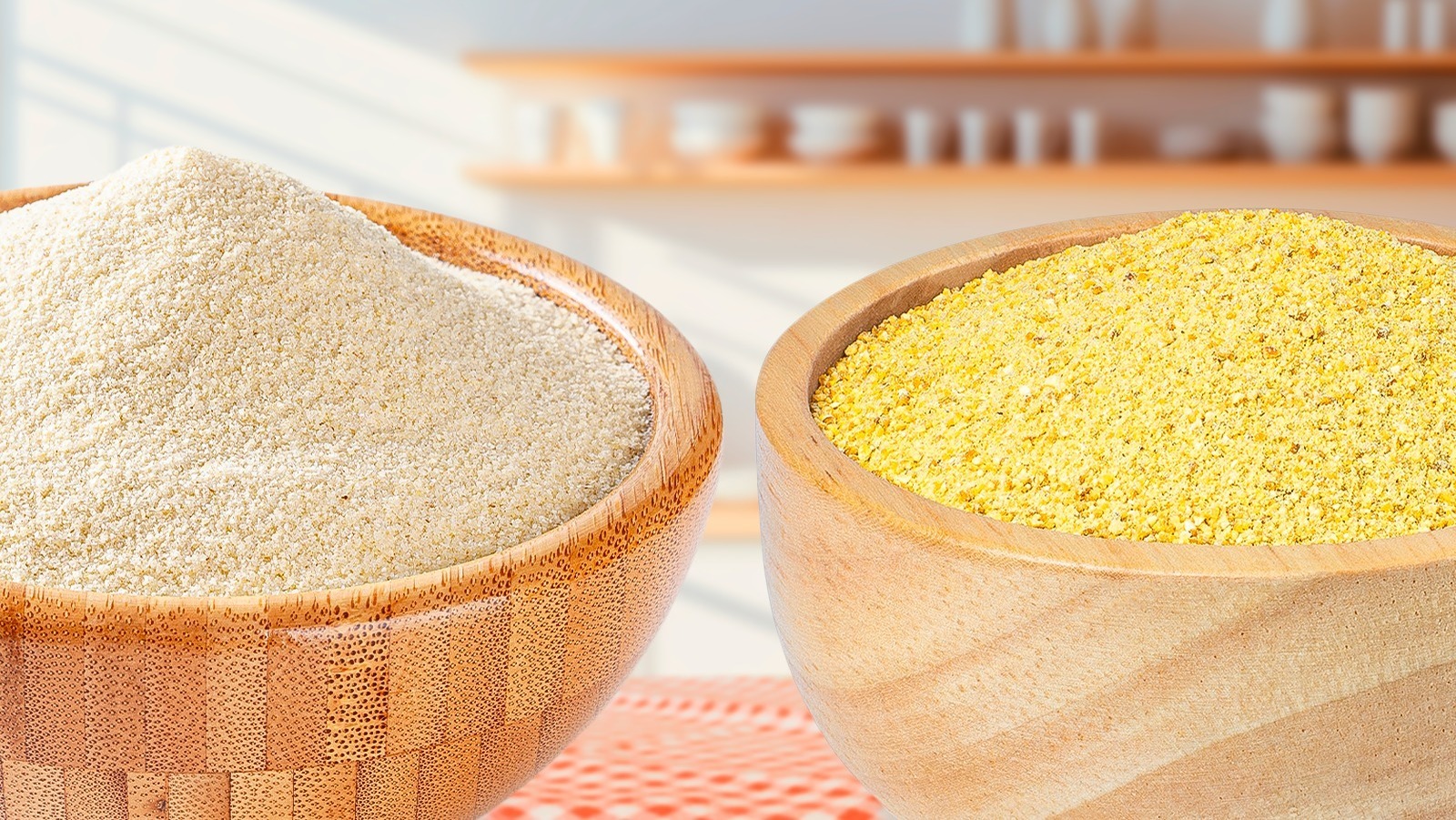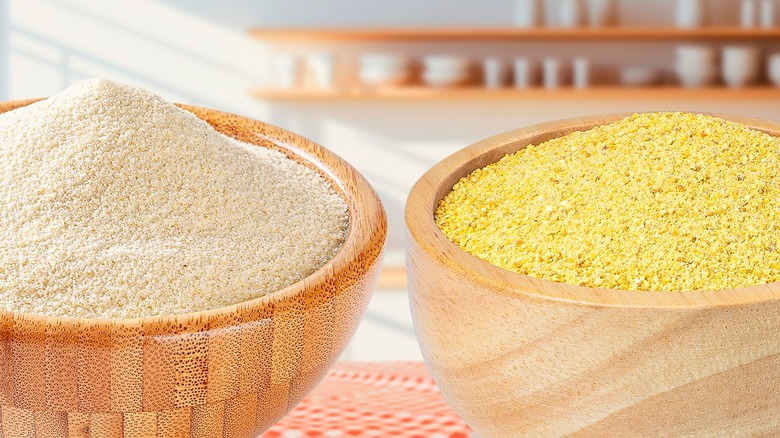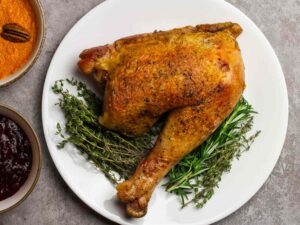No, semolina is not the same as cornmeal. Both are popular ingredients in many recipes.
But they come from different grains and have distinct textures and uses. Semolina is made from durum wheat. It has a coarse texture and a slightly yellow color. Often used in pasta, bread, and desserts, semolina is rich in protein and gluten.
Cornmeal, on the other hand, is ground from dried corn. It comes in fine, medium, and coarse varieties. Cornmeal is a staple in many cultures, used in dishes like cornbread, polenta, and tortillas. Understanding the differences between these two ingredients can help you choose the right one for your cooking needs. Let’s explore their unique characteristics and culinary uses.
Introduction To Semolina And Cornmeal
Have you ever wondered what makes semolina and cornmeal different? Both are popular in many kitchens. They are used in various dishes around the world. Let’s dive into what makes each of them unique.
Basics Of Semolina
Semolina is a coarse flour. It is made from durum wheat. This wheat is a hard type of wheat. Semolina has a yellow color and a slightly nutty flavor.
Semolina is often used to make pasta. It gives pasta its firm texture. It is also used in making bread and couscous. In some cultures, semolina is used to make a porridge or dessert.
Here is a quick look at semolina:
| Characteristic | Description |
|---|---|
| Source | Durum Wheat |
| Color | Yellow |
| Texture | Coarse |
| Common Uses | Pasta, Bread, Couscous, Porridge |
Basics Of Cornmeal
Cornmeal is made from dried corn. It is ground into a fine, medium, or coarse texture. Cornmeal has a distinct corn flavor and can be yellow, white, or blue.
It is a staple in many kitchens. Cornmeal is used to make cornbread, muffins, and tortillas. It is also used as a coating for fried foods.
Here is a quick look at cornmeal:
| Characteristic | Description |
|---|---|
| Source | Dried Corn |
| Color | Yellow, White, Blue |
| Texture | Fine, Medium, Coarse |
| Common Uses | Cornbread, Muffins, Tortillas, Coating for Fried Foods |

Credit: www.alamy.com
Origins And Production
Understanding the origins and production of semolina and cornmeal is essential to grasp their differences. Both have rich histories and distinct production processes. Let’s explore these aspects in detail.
History Of Semolina
Semolina has a long history, tracing back to ancient civilizations. It was a staple in the diets of ancient Romans and Greeks. They used semolina to make bread and other dishes. Semolina is made from durum wheat, a hard variety of wheat with high protein content. This gave it a unique texture and flavor, making it popular in Mediterranean cuisine.
History Of Cornmeal
Cornmeal’s history is deeply rooted in the Americas. Native Americans were the first to use cornmeal. They ground dried corn kernels to make a variety of foods. This practice spread to European settlers, who adopted cornmeal in their diets. Cornmeal became a staple in Southern United States cuisine. It is used in dishes like cornbread, grits, and polenta.
Production Process
The production processes for semolina and cornmeal differ significantly. Here’s a table to highlight the key differences:
| Semolina | Cornmeal |
|---|---|
| Made from durum wheat | Made from dried corn kernels |
| Wheat is cleaned and tempered | Corn is cleaned and hulled |
| Ground into coarse particles | Ground into fine, medium, or coarse meal |
| Used in pasta, couscous, and desserts | Used in cornbread, grits, and polenta |
The production of semolina involves cleaning and tempering the wheat. The wheat is then ground into coarse particles. These particles are sifted to separate the semolina from the bran and germ. The result is a coarse, yellow flour with a distinct texture.
Cornmeal production starts with cleaning and hulling the corn kernels. The kernels are then ground into a meal of varying coarseness. The grinding process determines whether the cornmeal is fine, medium, or coarse. The final product is used in a variety of dishes, from cornbread to polenta.
Physical Characteristics
Understanding the physical characteristics of semolina and cornmeal is key to differentiating them. They have distinct textures and colors, which can affect your cooking and baking results.
Texture Differences
One of the main differences between semolina and cornmeal is their texture. Semolina has a grainy texture due to its coarser grind. It feels somewhat rough to the touch.
In contrast, cornmeal is available in various grinds, ranging from fine to coarse. The texture can be smooth and powdery or slightly gritty, depending on the grind.
| Characteristic | Semolina | Cornmeal |
|---|---|---|
| Texture | Grainy, coarse | Varies from fine to coarse |
Color Variations
The color of semolina and cornmeal also provides clues to their identity. Semolina is typically yellow due to its durum wheat origin. It has a bright, golden hue.
Cornmeal color varies based on the type of corn used. It can be yellow, white, or even blue. The most common is yellow cornmeal, which has a sunny, bright color.
- Semolina: Yellow, golden
- Cornmeal: Yellow, white, or blue
Nutritional Content
Understanding the nutritional content of semolina and cornmeal can help you make informed dietary choices. Both are popular ingredients, but they offer different benefits. Let’s dive into the nutritional profiles of each to see how they compare.
Nutritional Profile Of Semolina
Semolina is made from durum wheat and is high in protein and fiber. Below is the nutritional breakdown of a 100-gram serving of semolina:
| Nutrient | Amount |
|---|---|
| Calories | 360 kcal |
| Protein | 12.7 g |
| Carbohydrates | 72 g |
| Fiber | 3.9 g |
| Fat | 1.1 g |
| Iron | 1.23 mg |
| Magnesium | 47 mg |
Semolina is rich in protein and carbohydrates. It also provides important minerals like iron and magnesium. These nutrients are essential for energy and overall health.
Nutritional Profile Of Cornmeal
Cornmeal, made from ground corn, has a different nutritional profile. Here’s what you get from a 100-gram serving of cornmeal:
| Nutrient | Amount |
|---|---|
| Calories | 370 kcal |
| Protein | 9.4 g |
| Carbohydrates | 79 g |
| Fiber | 7.3 g |
| Fat | 3.9 g |
| Iron | 2.4 mg |
| Magnesium | 127 mg |
Cornmeal is higher in fiber and magnesium compared to semolina. It’s also a good source of carbohydrates and provides more fat than semolina. This makes it a versatile ingredient for many dishes.
By comparing these two, you can see that both semolina and cornmeal offer unique benefits. Understanding their nutritional content can help you decide which to use in your meals.
Culinary Uses
Semolina and cornmeal are staples in many kitchens. Both have unique textures and flavors. They are versatile and used in a variety of recipes. Understanding their culinary uses helps make the most of these ingredients.
Popular Recipes With Semolina
Semolina is a coarse flour made from durum wheat. It has a slightly nutty flavor. It is often used in pasta, bread, and desserts.
- Semolina Pasta: A popular use for semolina. It gives the pasta a firm texture.
- Semolina Bread: Adds a unique flavor and texture to the bread.
- Halva: A sweet dessert made with semolina, sugar, and butter.
These recipes showcase semolina’s versatility. It can be used in both savory and sweet dishes.
Popular Recipes With Cornmeal
Cornmeal is made from ground dried corn. It has a slightly sweet taste. It is a key ingredient in many traditional dishes.
- Cornbread: A classic dish. Cornmeal gives it a unique flavor and texture.
- Polenta: A creamy dish made from boiled cornmeal. It can be served soft or allowed to set and then fried.
- Hush Puppies: Deep-fried balls of cornmeal batter. They are a popular side dish in the southern United States.
Cornmeal’s unique texture and flavor make it ideal for a variety of recipes. From breads to side dishes, it adds a special touch to meals.

Credit: www.tastingtable.com
Health Benefits
Both semolina and cornmeal offer various health benefits. These grains are packed with essential nutrients that can enhance your overall well-being. Let’s dive into the specific health advantages of each.
Health Benefits Of Semolina
Semolina is a rich source of protein and fiber. These nutrients help in maintaining muscle mass and digestive health.
- High in Protein: Semolina contains about 12 grams of protein per cup. This makes it a great choice for those looking to increase their protein intake.
- Rich in Fiber: Fiber helps in regulating your digestive system. Semolina provides about 7 grams of fiber per cup.
- Good Source of B Vitamins: B vitamins are essential for energy production. Semolina is rich in B vitamins like folate and thiamine.
- Low Glycemic Index: Semolina helps in controlling blood sugar levels. This is beneficial for people with diabetes.
Health Benefits Of Cornmeal
Cornmeal is another grain with numerous health benefits. It is gluten-free and rich in essential nutrients.
- Gluten-Free: Cornmeal is naturally gluten-free, making it suitable for those with celiac disease.
- Rich in Iron: Iron is crucial for blood health. Cornmeal offers a good amount of iron, which helps in preventing anemia.
- High in Antioxidants: Cornmeal contains antioxidants like lutein and zeaxanthin. These are beneficial for eye health.
- Good Source of Fiber: Like semolina, cornmeal is also high in fiber. This helps in maintaining a healthy digestive system.
Common Substitutes
When it comes to cooking and baking, finding the right substitutes can be crucial. Sometimes, you might run out of semolina or cornmeal and need a quick replacement. This section will guide you through some common substitutes for both ingredients. Whether you are making bread, pasta, or a delicious dessert, these alternatives will help you achieve similar results.
Substitutes For Semolina
Semolina is a coarse flour made from durum wheat. It is often used in pasta, bread, and desserts. If you don’t have semolina on hand, consider these substitutes:
- All-Purpose Flour: This is a versatile substitute. Use it in a 1:1 ratio for most recipes.
- Whole Wheat Flour: Offers a similar texture. It also adds a nutty flavor to your dish.
- Bread Flour: Has a higher gluten content. Ideal for bread and pasta making.
- Cornmeal: For a different texture, cornmeal can work. It adds a unique taste.
- Rice Flour: Suitable for gluten-free recipes. It offers a fine texture.
Substitutes For Cornmeal
Cornmeal is ground dried corn. It is used in cornbread, muffins, and as a coating for fried foods. If you need a substitute for cornmeal, try these options:
- Polenta: This is a type of cornmeal. It is coarser and works well in most recipes.
- Semolina: Provides a different flavor but a similar texture. Great for baking.
- All-Purpose Flour: Can be used in a pinch. It won’t have the same grainy texture.
- Ground Oats: Offers a unique flavor and texture. Blend oats to a fine powder.
- Ground Flaxseed: Adds a nutty flavor. It is also a healthy alternative.

Credit: www.bobsredmill.com
Frequently Asked Questions
What Is Semolina Made From?
Semolina is made from durum wheat. It has a coarse texture and is often used in pasta and couscous.
Is Cornmeal The Same As Semolina?
No, cornmeal and semolina are different. Cornmeal is made from ground corn, while semolina is from durum wheat.
Can Semolina Be Used Instead Of Cornmeal?
Semolina can sometimes substitute cornmeal, but the textures and flavors differ. It depends on the recipe requirements.
What Are Common Uses For Semolina?
Semolina is commonly used in pasta, couscous, and some bread recipes. It provides a distinct texture and flavor.
Conclusion
Semolina and cornmeal have distinct differences. Semolina comes from durum wheat. Cornmeal comes from dried corn. They vary in texture and taste. Semolina is coarser and yellow. Cornmeal is finer and can be yellow or white. Each suits different recipes.
Understanding these differences helps in cooking. Choose semolina for pasta and pudding. Use cornmeal for cornbread and polenta. Both are versatile and nutritious. Knowing their unique traits enhances your dishes.




